Lilium pardalinum ssp. vollmeri
Lilium pardalinum ssp. pardalinum
Vollmer's lily
leopard lily
whorled (scattered in small plants); more or less linear.
whorled.
flowers 1–13.
flowers 1–28.
perianth segments 4.8–8.1 cm, 2-toned;
tips darker;
stamens longer than perianth;
anthers 5–18 mm; magenta or purple;
pollen red-orange or orange;
pistil 3.5–5.3 cm.
rarely fragrant;
perianth segments 5.6–9.3 cm, 2-toned;
tips darker;
stamens much longer than perianth;
anthers 9–22 mm; pale magenta or magenta, becoming purple or rarely yellowish;
pollen red- to brown-orange;
pistil 4.5–7.6 cm.
2.5–5 cm.
3–6 cm.
=24.
Lilium pardalinum ssp. vollmeri
Lilium pardalinum ssp. pardalinum
Bogs, streams, and springs. Flowering Jun–Aug. 100– 1500m. Sisk. CA. Native.
Vollmer’s lily is quite variable, and phenotypic expression is highly dependent on environment and soils. Around the geographic edges of this range, identification becomes more difficult, and ssp. vollmeri intergrades with other subspecies of pardalinum along all its boundaries to produce morphologically jumbled intermediates. Even within the core range of the subspecies, plants in deep shade generally have scattered, wider leaves that much resemble ssp. pardalinum. Like most L. pardalinum, Vollmer’s lily is pollinated in Oregon by pale and western tiger swallowtails and also visited by rufous hummingbirds.
Stream banks, seeps, springs, fens, and roadside ditches. Flowering Jul–Aug. 300–1600m. Casc, Sisk. CA. Native.
Quite variable in flower size, color, and leaf size and shape, ssp. pardalinum is the easiest of the western lilies to cultivate, although the strongly clonal material of the best California stock is preferred for its vigor and strongly marked flowers. Oregon plants often have narrowly elliptic leaves and slightly smaller perianth segments and paler flowers than their California counterparts. Plants north of Pelican Bay in Klamath County are near the northern boundary of ssp. shastense and show the floral deformities characteristic of introgression zones, including missing stamens and shrunken, malformed petals. There are some differences between the Oregon and California spp. pardalinum plants, and some might advocate description of a sixth subspecies to encompass the Cascadian material. Cascade plants are generally less clonal and less robust with smallspotted, pale orange flowers, broad petals, and pale reddish tepal tips, in contrast to California ssp. pardalinum with its tightly clumped stems, blazing reddish tepal tips and dramatic leopard spots. However, the appearance of plants that recapitulate the essence of California ssp. pardalinum, on non-serpentine basaltic soils, to the north of well-marked ssp. Vollmeri complicates the picture; these plants, north of Agnes in Curry County, are robust, quite clonal, and have the broadly elliptic leaves and large flowers typical of spp. pardalinum. Similar populations appear various places in the Oregon Cascades, especially north of Prospect around Kiter and Mill Creeks. Therefore it seems that the current California circumscription of ssp. pardalinum can and should be slightly enlarged to embrace the Oregon plants here included in it.
Mark Skinner
Mark Skinner





